TCP Tests
Description
The goal of the TCP tests was to get an impression about the performance of the
site local loop Force10 - Cisco 6509 - AR5 loop. As had already
been mentioned in the
"Performed Experiments"
section,
the removing of an intrinsic 8 Gbits/s bottleneck in
the Cisco 6509 by an upgrade of this switch will be investigated. Also
the effect of some Web100 Linux kernel
parameter settings will be shown. Also the effect of MTU settings will be
investigated.
As mentioned in the "Setup"
section, The DAS-2 cluster nodes have
been separated into two VLAN's. TCP flows have been generated between cluster
nodes pairs, located in both VLAN's that have been generated with the
Iperf V. 1.6.5 traffic
generator. Because the goal in these tests was to measure the performance of the
route, each flow had been generated between a single source and destination
host. The TCP tests has been executed as a function of the # source -
destination node pairs, the # parallel flows per node pair (generated by
Iperf using the
pthread library) and the TCP window size which will be varied such that
the sum of the TCP window over the parallel flows per node pair will be kept
constant. This makes it possible to able to compare the effect of the
# parallel flows per node pair. Due to the small round-trip it can be
expected that the effect of TCP window size variation will be limited.
Results
In the subsections below TCP throughput results will be presented for the
situations described above in the following order:
To be able to register the traffic reliable in the SNMP counters of the network
equipment, also a TCP test using flows with a duration of 30 min. have been
executed:
Bottleneck 6509: 8 Gbits/s;
No Web100 Buffer Resize; MTU: 1500 Bytes
In this subsection results will be presented of TCP tests that had been executed
under the circumstances that the Cisco 6509 still was constrained with an
internal bottleneck of 8 Gbits/s. In these
Web100 kernel parameters has been defined
such that the receive and send buffer sizes are no longer automatically adjusted
to the congestion window (cwnd). This can be done by setting the
/proc pseudo file system entries
/proc/sys/net/ipv4/web100_sbufmode and
/proc/sys/net/ipv4/web100_rbufmode to zero. Their default value is
one. Alternatively the command
sysctl -w net.ipv4.web100_rbufmode=0
net.ipv4.web100_sbufmode=0
could be run.
The TCP throughput tests were performed as they have been described in the
"Description" section above. These tests had
been executed with 1 to 11 node pairs (at that moment the maximum
available number) and with 1 to 10 parallel flows per node pair. The
used MTU was 1500 Bytes. In the
plots of these TCP throughput values as a function of the # node pairs and
of the # parallel flows per node pair have been presented for window sizes
of 32,
64,
128 and
256 KBytes.
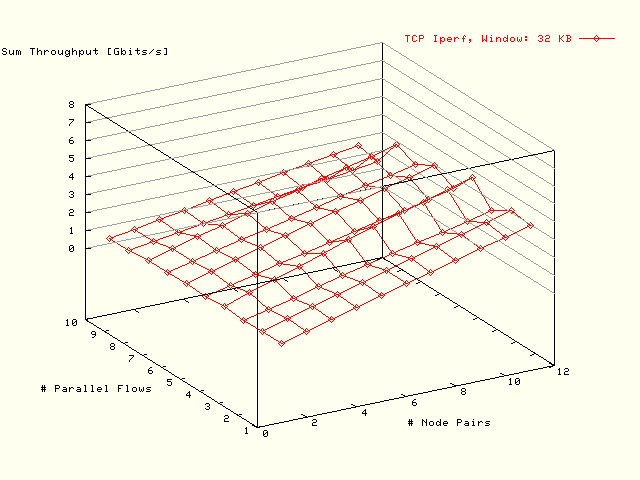
| . |
|
Sum TCP throughput values as a function of the
# node pairs and the # parallel flows per node pair. The sum of
the TCP window size, taken over the # parallel flows per node pair,
was 32 KBytes. There was an intrinsic bottleneck of 8 Gbits/s at
the 6509 switch. The socket buffer resizing had been switched off in
the Web100 kernel. MTU:
1500 Bytes. |
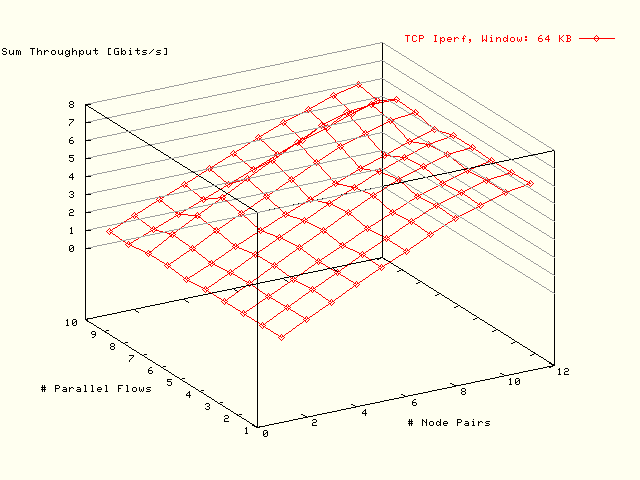
| . |
|
Sum TCP throughput values as a function of the
# node pairs and the # parallel flows per node pair. The sum of
the TCP window size, taken over the # parallel flows per node pair,
was 64 KBytes. There was an intrinsic bottleneck of 8 Gbits/s at
the 6509 switch. The socket buffer resizing had been switched off in
the Web100 kernel. MTU:
1500 Bytes. |
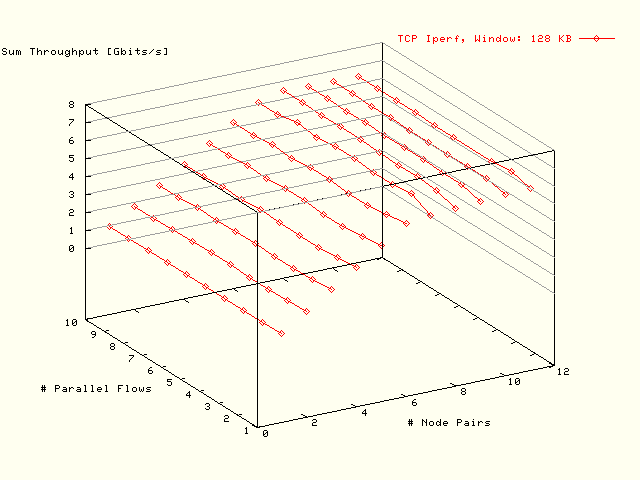
| . |
|
Sum TCP throughput values as a function of the
# node pairs and the # parallel flows per node pair. The sum of
the TCP window size, taken over the # parallel flows per node pair,
was 128 KBytes. There was an intrinsic bottleneck of 8 Gbits/s at
the 6509 switch. The socket buffer resizing had been switched off in
the Web100 kernel. MTU:
1500 Bytes. |
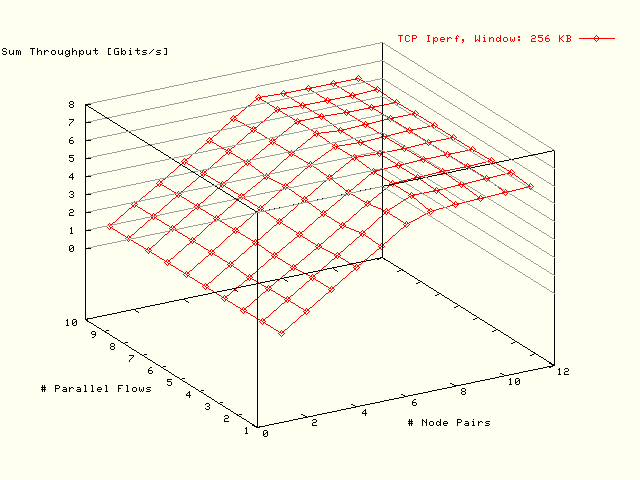
| . |
|
Sum TCP throughput values as a function of the
# node pairs and the # parallel flows per node pair. The sum of
the TCP window size, taken over the # parallel flows per node pair,
was 256 KBytes. There was an intrinsic bottleneck of 8 Gbits/s at
the 6509 switch. The socket buffer resizing had been switched off in
the Web100 kernel. MTU:
1500 Bytes. |
A remarkable result from this test is the low achieved bandwidth for TCP
windows ≤ 64 KByte
(
).
Bottleneck 6509: 8 Gbits/s;
No Web100 Buffer Resize; MTU: 8176 Bytes
In the
the results of equivalent tests are presented as in the
previous subsection, but here a MTU
of 8176 Bytes has been used.

| . |
|
Sum TCP throughput values as a function of the
# node pairs and the # parallel flows per node pair. The sum of
the TCP window size, taken over the # parallel flows per node pair,
was 32 KBytes. There was an intrinsic bottleneck of 8 Gbits/s at
the 6509 switch. The socket buffer resizing had been switched off in
the Web100 kernel. MTU:
8176 Bytes. |

| . |
|
Sum TCP throughput values as a function of the
# node pairs and the # parallel flows per node pair. The sum of
the TCP window size, taken over the # parallel flows per node pair,
was 64 KBytes. There was an intrinsic bottleneck of 8 Gbits/s at
the 6509 switch. The socket buffer resizing had been switched off in
the Web100 kernel. MTU:
8176 Bytes. |

| . |
|
Sum TCP throughput values as a function of the
# node pairs and the # parallel flows per node pair. The sum of
the TCP window size, taken over the # parallel flows per node pair,
was 128 KBytes. There was an intrinsic bottleneck of 8 Gbits/s at
the 6509 switch. The socket buffer resizing had been switched off in
the Web100 kernel. MTU:
8176 Bytes. |

| . |
|
Sum TCP throughput values as a function of the
# node pairs and the # parallel flows per node pair. The sum of
the TCP window size, taken over the # parallel flows per node pair,
was 256 KBytes. There was an intrinsic bottleneck of 8 Gbits/s at
the 6509 switch. The socket buffer resizing had been switched off in
the Web100 kernel. MTU:
8176 Bytes. |
From the
there follows that there is no improvement compared with the experiments where a
MTU of 1500 Bytes has been used
().
To check if these low throughput values have been caused by the
Web100 kernel parameter settings for the
receive and send buffer sizes, the TCP tests will be repeated with the default
Linux kernel resize settings. In the
Bottleneck 6509: 8 Gbits/s;
Default Buffer Resize; MTU: 1500 Bytes
In this subsection equivalent results will be presented as in the previous two
subsections without buffer resizing with MTU values of
1500 and
8176 Bytes, but here the default
Linux (and Web100) buffer resizing
mechanisms will be used with an MTU of 1500 Bytes. In the
plots of these TCP throughput values as a function of the # node pairs and
of the # parallel flows per node pair have been presented for window sizes
of 32,
64,
128 and
256 KBytes.

| . |
|
Sum TCP throughput values as a function of the
# node pairs and the # parallel flows per node pair. The sum of
the TCP window size, taken over the # parallel flows per node pair,
was 32 KBytes. There was an intrinsic bottleneck of 8 Gbits/s at
the 6509 switch. The default socket buffer resizing mechanisms had been
used. MTU: 1500 Bytes. |

| . |
|
Sum TCP throughput values as a function of the
# node pairs and the # parallel flows per node pair. The sum of
the TCP window size, taken over the # parallel flows per node pair,
was 64 KBytes. There was an intrinsic bottleneck of 8 Gbits/s at
the 6509 switch. The default socket buffer resizing mechanisms had been
used. MTU: 1500 Bytes. |

| . |
|
Sum TCP throughput values as a function of the
# node pairs and the # parallel flows per node pair. The sum of
the TCP window size, taken over the # parallel flows per node pair,
was 128 KBytes. There was an intrinsic bottleneck of 8 Gbits/s at
the 6509 switch. The default socket buffer resizing mechanisms had been
used. MTU: 1500 Bytes. |

| . |
|
Sum TCP throughput values as a function of the
# node pairs and the # parallel flows per node pair. The sum of
the TCP window size, taken over the # parallel flows per node pair,
was 256 KBytes. There was an intrinsic bottleneck of 8 Gbits/s at
the 6509 switch. The default socket buffer resizing mechanisms had been
used. MTU: 1500 Bytes. |
When these results are compared with those from the previous two subsections,
where the socket buffer resizing has been switched off for MTU values of
1500 and
8176 Bytes
(),
there follows that switching off the buffer resizing appeared to be a
disadvantage for these short round-trip times, although it might be beneficial
for longer round-trip times. In the sequel of these tests the default buffer
resizing will be used.
In the next subsection the MTU will be
set to 8192 Bytes to check if that would lead to a higher throughput.
Bottleneck 6509: 8 Gbits/s;
Default Buffer Resize; MTU: 8192 Bytes
In this subsection equivalent results will be presented as in the
previous section, but here with an MTU
of 8192 Bytes. In the
plots of these TCP throughput values as a function of the # node pairs and
of the # parallel flows per node pair have been presented for window sizes
of 32,
64,
128 and
256 KBytes.

| . |
|
Sum TCP throughput values as a function of the
# node pairs and the # parallel flows per node pair. The sum of
the TCP window size, taken over the # parallel flows per node pair,
was 32 KBytes. There was an intrinsic bottleneck of 8 Gbits/s at
the 6509 switch. The default socket buffer resizing mechanisms had been
used. MTU: 8192 Bytes. |

| . |
|
Sum TCP throughput values as a function of the
# node pairs and the # parallel flows per node pair. The sum of
the TCP window size, taken over the # parallel flows per node pair,
was 64 KBytes. There was an intrinsic bottleneck of 8 Gbits/s at
the 6509 switch. The default socket buffer resizing mechanisms had been
used. MTU: 8192 Bytes. |

| . |
|
Sum TCP throughput values as a function of the
# node pairs and the # parallel flows per node pair. The sum of
the TCP window size, taken over the # parallel flows per node pair,
was 128 KBytes. There was an intrinsic bottleneck of 8 Gbits/s at
the 6509 switch. The default socket buffer resizing mechanisms had been
used. MTU: 8192 Bytes. |

| . |
|
Sum TCP throughput values as a function of the
# node pairs and the # parallel flows per node pair. The sum of
the TCP window size, taken over the # parallel flows per node pair,
was 256 KBytes. There was an intrinsic bottleneck of 8 Gbits/s at
the 6509 switch. The default socket buffer resizing mechanisms had been
used. MTU: 8192 Bytes. |
When these results are compared with those from the
previous section, where a MTU value
of 1500 Bytes has been used
(),
there follows that the larger MTU used here does indeed lead to a slight
performance improvement.
No Bottleneck 6509; Default Buffer
Resize: MTU: 8192 Bytes
In this subsection the results of TCP tests will be shown that were executed
after the intrinsic bottleneck of the Cisco 6509 had been removed by an
upgrade and from the network point of view there was no limitation anymore to
achieve the provided bandwidth of 10 Gbits/s.
As in the previous subsections, the TCP tests had been executed as a function of
the # source - destination node pairs, the # parallel flows per
node pair and the TCP window size which had been varied such that the sum of the
TCP window over the parallel flows per node pair will be kept constant. In these
tests 5 to 12 node pairs (one extra node pair came available compared
with the tests before) had been used and 1 to 10 parallel
flows per node pair. The used MTU was 8192 Bytes. In the
these plots have been presented for window sizes of
32,
64,
128 and
256 KBytes.

| . |
|
Sum TCP throughput values as a function of the
# node pairs and the # parallel flows per node pair. The sum of
the TCP window size, taken over the # parallel flows per node pair,
was 32 KBytes. There was no bottleneck in the network equipment anymore
in relation with the provided bandwidth of 10 Gbits/s. The default
socket buffer resizing mechanisms had been used. MTU:
8192 Bytes. |

| . |
|
Sum TCP throughput values as a function of the
# node pairs and the # parallel flows per node pair. The sum of
the TCP window size, taken over the # parallel flows per node pair,
was 64 KBytes. There was no bottleneck in the network equipment anymore
in relation with the provided bandwidth of 10 Gbits/s. The default
socket buffer resizing mechanisms had been used. MTU:
8192 Bytes. |

| . |
|
Sum TCP throughput values as a function of the
# node pairs and the # parallel flows per node pair. The sum of
the TCP window size, taken over the # parallel flows per node pair,
was 128 KBytes. There was no bottleneck in the network equipment
anymore in relation with the provided bandwidth of 10 Gbits/s. The
default socket buffer resizing mechanisms had been used. MTU:
8192 Bytes. |

| . |
|
Sum TCP throughput values as a function of the
# node pairs and the # parallel flows per node pair. The sum of
the TCP window size, taken over the # parallel flows per node pair,
was 256 KBytes. There was no bottleneck in the network equipment
anymore in relation with the provided bandwidth of 10 Gbits/s. The
default socket buffer resizing mechanisms had been used. MTU:
8192 Bytes. |
From the
there follows that the provided bandwidth could well be reached. That is also
the case with 11 node pairs, the # node pairs that were available for
the upgrade of the 6509 switch. None of the network and host equipment
seems to be a bottleneck with the topology used in these tests.
No Bottleneck 6509; Flows of
30 Min.
To be able to register the traffic reliable in the SNMP counters of the network
equipment, also a TCP test with flows lasting for 30 min. have been
executed. These tests had been executed after the upgrade of the
6509 switch. Twelve node pairs had been used with a single flow per node
pair using a TCP window of 128 KBytes. The MTU was 8192 bytes. In
the bandwidth values are listed for the individual flows and for their sum.
Flow
[#] |
Bandwidth
[Mbits/s] |
Flow
[#] |
Bandwidth
[Mbits/s] |
| 1 |
789 |
7 |
846 |
| 2 |
713 |
8 |
802 |
| 3 |
841 |
9 |
843 |
| 4 |
856 |
10 |
851 |
| 5 |
843 |
11 |
825 |
| 6 |
765 |
12 |
758 |
| |
|
Sum |
9732 |
| . |
|
Bandwidth of the individual flows between
12 node pairs and their sum. The duration of the flows was 30 min.
No bottlenecks were involved, so the provided bandwidth was 10 Gbits/s.
MTU: 8192 Bytes. |
In
the corresponding SNMP registration is presented from
SURFnet at the interface of the
6509 switch to which the Force10 switch has been connected. Please note
that the 30 min. TCP tests had been started at 11:28.
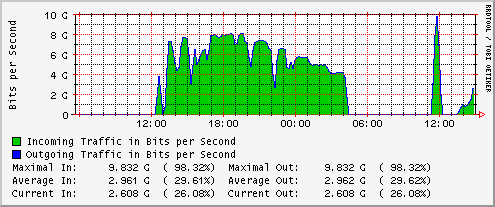
| . |
|
SNMP registration from
SURFnet at the interface of the
6509 switch to which the Force10 switch has been connected. It was
taken during the 30 min. TCP tests from which the results have been
listed in
.
These tests had been started at 11:28. |
In
a maximum bandwidth of 9.8 Gbits/s has been registered. In
the sum of the bandwidth values is 9.7 Gbits/s. Both values are in good
agreement with each other.
Conclusions
From the TCP tests presented above, the following
conclusions can be drawn:
-
Switching off the default resizing of the send and receive buffer sizes in
the Web100 kernel are not beneficial
for small TCP window sizes (≤ 64 KBytes). In the sequel the
default resizing behaviour will be used.
-
In the situation with the 8 Gbits/s bottleneck of the 6509 switch,
the maximum achieved throughput was 7 Gbits/s. This is not a bad result
concerning the mismatch in provided bandwidths between the Force10 switch
and the 6509.
-
After the upgrade of the 6509 switch, the provided bandwidth of
10 Gbits/s could be filled without problems which could be concluded
both from the achieved throughput values and from the SNMP registrations.
From these TCP tests there follows that the connection between Force10
and 6509 does not seem to introduce problems.
-
Using larger MTU sizes larger than the default 1500 bytes is beneficial
for high throughput values that are nearing the provided bandwidth.




















